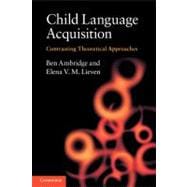
Note: Supplemental materials are not guaranteed with Rental or Used book purchases.
Purchase Benefits
What is included with this book?
| List of figures | p. vii |
| List of tables | p. x |
| List of boxes | p. xi |
| List of summary tables | p. xii |
| Preface | p. xiii |
| Acknowledgements | p. xv |
| Introduction | p. 1 |
| The major theoretical approaches | p. 1 |
| The domains and debates | p. 4 |
| Methodologies | p. 6 |
| Speech perception, segmentation and production | p. 13 |
| Introduction | p. 13 |
| Characteristics of speech | p. 14 |
| Developing a phonemic inventory | p. 18 |
| Segmenting the speech stream into words, phrases and clauses | p. 31 |
| Speech production | p. 47 |
| Speech perception, segmentation and production: conclusion | p. 57 |
| Learning word meanings | p. 61 |
| Introduction | p. 61 |
| The constraints or 'principles' approach | p. 62 |
| The social-pragmatic approach | p. 70 |
| The associative learning approach | p. 83 |
| Syntactic bootstrapping | p. 89 |
| Conclusion: how do children learn the meanings of words? | p. 100 |
| Theoretical approaches to grammar acquisition | p. 103 |
| Generativist approaches | p. 103 |
| Constructivist approaches | p. 123 |
| Theoretical approaches to grammar acquisition: conclusion | p. 136 |
| Inflection | p. 137 |
| Introduction to inflection | p. 137 |
| Why do children fail to mark tense and agreement in obligatory contexts? | p. 144 |
| Are children less productive with morphology than adults? | p. 157 |
| Rules versus analogies in inflectional morphology (with special reference to the English past-tense debate) | p. 169 |
| Learning inflectional morphology: conclusion | p. 187 |
| Simple syntax | p. 191 |
| Identifying/constructing syntactic categories | p. 192 |
| Acquiring basic word order | p. 209 |
| The retreat from overgeneralization error | p. 242 |
| Simple syntax: conclusion | p. 265 |
| Movement and complex syntax | p. 269 |
| Non-canonical word orders (passives and questions) | p. 269 |
| Multiple-clause sentences | p. 289 |
| Movement and complex syntax: conclusion | p. 312 |
| Binding, quantification and control | p. 314 |
| Binding and coreference | p. 315 |
| Quantification | p. 335 |
| Control | p. 346 |
| Binding, quantification and control: conclusion | p. 357 |
| Related debates and conclusions | p. 359 |
| Related debates | p. 359 |
| Conclusions and future directions | p. 369 |
| Notes | p. 377 |
| References | p. 387 |
| Author index | p. 427 |
| Subject index | p. 432 |
| Table of Contents provided by Ingram. All Rights Reserved. |
The New copy of this book will include any supplemental materials advertised. Please check the title of the book to determine if it should include any access cards, study guides, lab manuals, CDs, etc.
The Used, Rental and eBook copies of this book are not guaranteed to include any supplemental materials. Typically, only the book itself is included. This is true even if the title states it includes any access cards, study guides, lab manuals, CDs, etc.